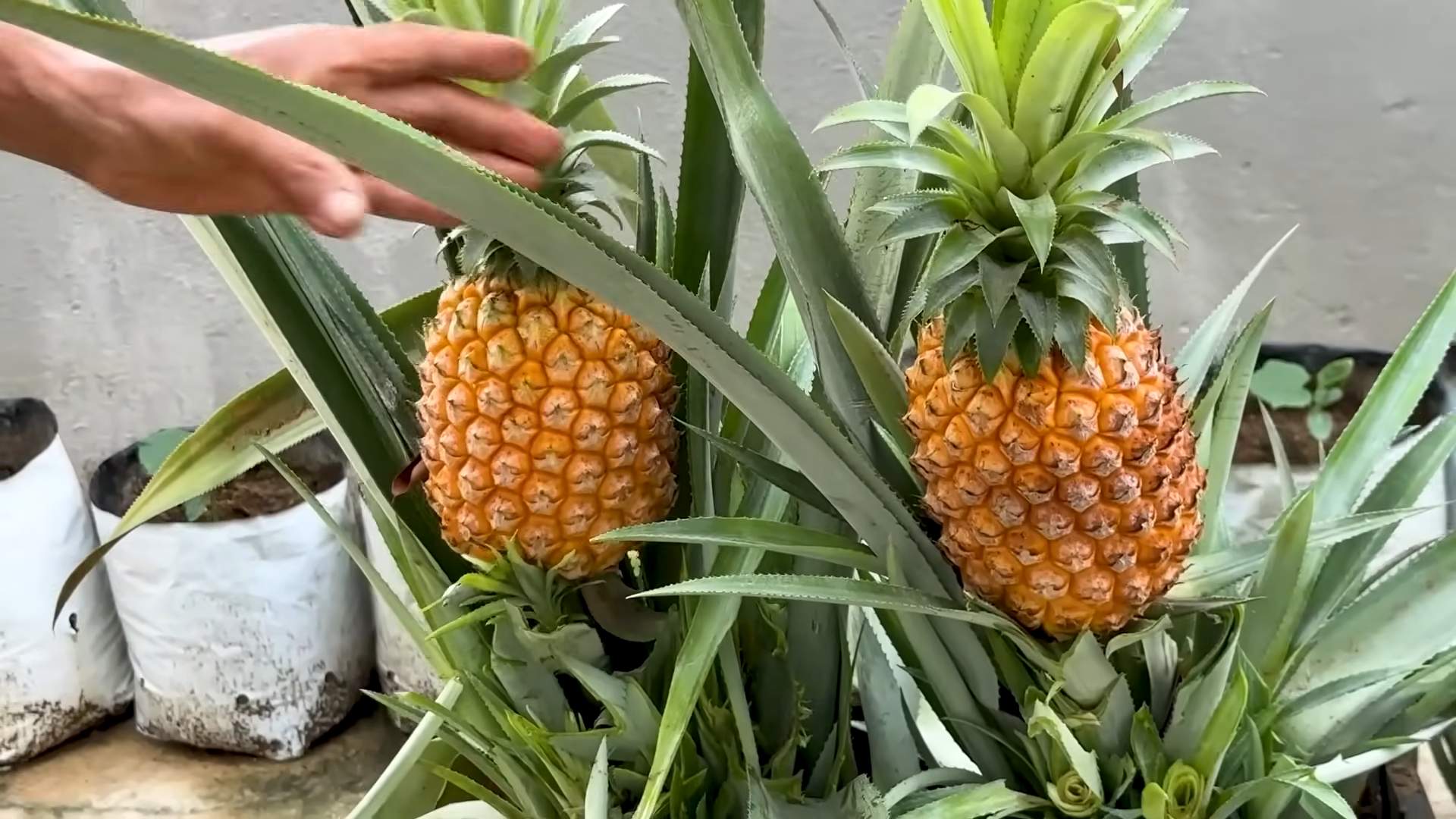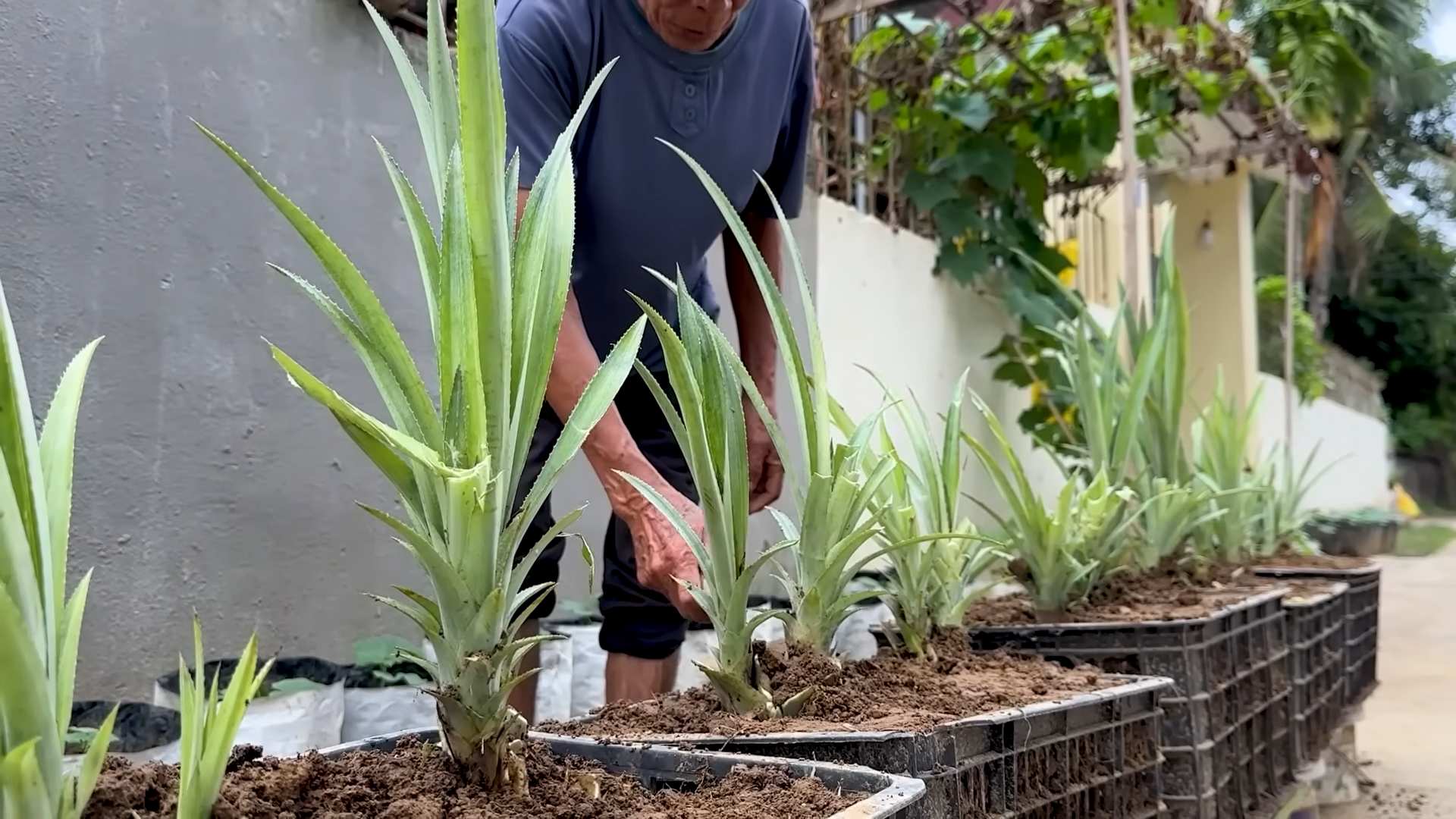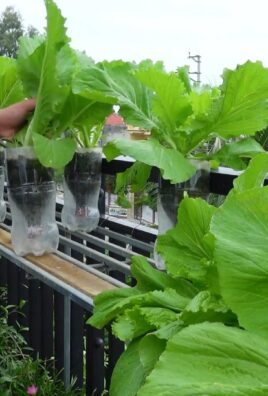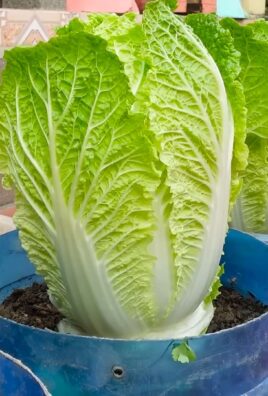Plant Pineapples at Home? Absolutely! Imagine the sweet, tropical aroma wafting from your very own homegrown pineapple. Forget those expensive grocery store pineapples – with a little know-how, you can cultivate this exotic fruit right in your backyard or even on your sunny balcony.
For centuries, pineapples have been a symbol of hospitality and luxury. Originating in South America, they were once so prized that they were rented out as status symbols for parties! Now, you don’t need to be royalty to enjoy this delicious fruit.
But why should you bother with this DIY project? Well, store-bought pineapples can be pricey, and let’s be honest, nothing beats the taste of a freshly picked, sun-ripened fruit. Plus, plant pineapples at home is a fantastic way to reduce your carbon footprint, learn a new skill, and impress your friends with your green thumb. I’m going to show you some simple tricks and hacks that will make growing your own pineapple a breeze, even if you’re a complete beginner. Get ready to transform your space into a tropical paradise, one pineapple at a time!

Growing Pineapples at Home: A Tropical Treat You Can DIY!
Okay, so you want to grow your own pineapple? Awesome! It’s surprisingly easier than you might think, and there’s nothing quite like the satisfaction of harvesting a sweet, juicy pineapple that you nurtured from a humble grocery store find. I’m going to walk you through the whole process, step-by-step, so you can enjoy your own homegrown tropical delight.
Choosing Your Pineapple and Preparing the Crown
The first and most crucial step is selecting the right pineapple. Not all pineapples are created equal when it comes to propagation.
* Look for a Healthy Pineapple: Choose a pineapple that’s ripe but not overripe. The leaves should be a vibrant green, and the fruit should have a pleasant, sweet smell. Avoid pineapples with brown, wilted, or damaged leaves.
* Check the Crown: The crown (the leafy top) is what you’ll be planting, so it needs to be in good shape. Make sure the leaves are firmly attached and free from any signs of rot or disease.
* Consider Variety (Optional): While most grocery store pineapples are the Smooth Cayenne variety, you might be able to find other types at specialty stores or farmers’ markets. Different varieties may have slightly different growth habits or fruit characteristics.
Once you’ve got your pineapple, it’s time to prepare the crown for planting. There are a couple of methods you can use, and I’ll explain both:
Method 1: Twisting Off the Crown
This is the method I usually use because it’s quick and easy.
1. Grip the Crown Firmly: Hold the pineapple fruit in one hand and the base of the crown in the other.
2. Twist and Pull: Twist the crown firmly while gently pulling it away from the fruit. You might need to apply a bit of force, but be careful not to damage the crown. The goal is to separate the crown with a clean break.
3. Remove Excess Fruit: After separating the crown, you’ll likely have some fruit flesh attached to the base. This can rot and cause problems, so carefully remove it. You can use a sharp knife to trim away the flesh, being careful not to damage the root primordia (those little brown bumps you’ll see at the base).
Method 2: Cutting Off the Crown
This method is a good alternative if you’re having trouble twisting off the crown or if you want to be extra careful.
1. Cut the Crown: Use a sharp knife to cut the crown off the pineapple, about an inch or two below the base of the leaves.
2. Remove Excess Fruit: As with the twisting method, carefully remove any remaining fruit flesh from the base of the crown.
3. Peel Back Lower Leaves: Gently peel back a few of the lower leaves from the base of the crown. This will expose more of the stem and encourage root growth.
Rooting the Pineapple Crown
Now that you’ve prepared the crown, it’s time to encourage root growth. There are two main ways to do this: water rooting and direct planting.
Water Rooting
This is a popular method because you can visually monitor root development.
1. Let the Crown Dry: Before placing the crown in water, let it dry for a few days (1-3 days is usually sufficient). This allows the cut end to callous over, which helps prevent rot. Place the crown in a well-ventilated area, away from direct sunlight.
2. Place in Water: Once the cut end has calloused, place the crown in a glass or jar of water, ensuring that only the base of the crown (where you removed the lower leaves) is submerged. Avoid submerging the leaves, as this can lead to rot.
3. Change the Water Regularly: Change the water every 1-2 days to keep it fresh and prevent the growth of bacteria or algae.
4. Wait for Roots: Place the jar in a bright, indirect light location. Be patient! It can take several weeks (usually 2-8 weeks) for roots to develop. You’ll start to see small white roots emerging from the base of the crown.
5. Plant When Roots are Established: Once the roots are about 2-3 inches long, it’s time to plant the crown in soil.
Direct Planting
This method involves planting the crown directly into soil without rooting it in water first. It can be a bit riskier, as there’s a higher chance of rot, but it can also be successful if done correctly.
1. Let the Crown Dry: As with water rooting, let the crown dry for a few days to allow the cut end to callous over.
2. Prepare the Pot: Choose a pot that’s at least 6 inches in diameter and has good drainage holes. Fill the pot with a well-draining potting mix. A mix of potting soil, perlite, and sand works well.
3. Plant the Crown: Make a hole in the center of the pot and carefully plant the crown, burying the base of the crown (where you removed the lower leaves) in the soil. The leaves should be above the soil surface.
4. Water Gently: Water the soil gently, just enough to moisten it. Avoid overwatering, as this can lead to rot.
5. Provide Warmth and Light: Place the pot in a warm, sunny location.
Planting and Caring for Your Pineapple Plant
Whether you rooted your pineapple crown in water or planted it directly in soil, the next steps are the same.
1. Choose the Right Pot: Pineapples need room to grow, so choose a pot that’s at least 10-12 inches in diameter. As the plant grows, you may need to repot it into a larger container.
2. Use Well-Draining Soil: Pineapples are susceptible to root rot, so it’s crucial to use a well-draining potting mix. A mix of potting soil, perlite, and sand is ideal. You can also add some compost to provide extra nutrients.
3. Provide Plenty of Sunlight: Pineapples thrive in full sun, so choose a location that receives at least 6-8 hours of direct sunlight per day. If you’re growing your pineapple indoors, place it near a sunny window or use a grow light.
4. Water Regularly: Water your pineapple plant when the top inch of soil feels dry to the touch. Water thoroughly, allowing excess water to drain out of the bottom of the pot. Avoid overwatering, as this can lead to root rot.
5. Fertilize Regularly: Pineapples are heavy feeders, so fertilize your plant regularly during the growing season (spring and summer). Use a balanced fertilizer (e.g., 10-10-10) diluted to half strength. Fertilize every 2-4 weeks.
6. Maintain Warm Temperatures: Pineapples are tropical plants and prefer warm temperatures. Ideally, keep your plant in a location where the temperature is between 65°F and 85°F (18°C and 29°C). Protect your plant from frost and cold drafts.
7. Watch for Pests and Diseases: Pineapples can be susceptible to pests such as mealybugs and scale. Inspect your plant regularly and treat any infestations promptly. Root rot is a common problem, so avoid overwatering and ensure good drainage.
8. Be Patient: Growing a pineapple from a crown takes time. It can take anywhere from 2 to 3 years for your plant to produce a fruit. Don’t get discouraged if you don’t see results right away.
Encouraging Fruiting (Optional)
Sometimes, even with the best care, a pineapple plant may be reluctant to fruit. There’s a trick you can use to encourage fruiting:
1. Apple Core Method: Place a ripe apple core near the base of the plant and cover it with a container or plastic bag to trap the ethylene gas released by the apple. Ethylene gas is a natural plant hormone that can stimulate flowering. Leave the apple core in place for a few days, then remove it.
2. Calcium Carbide Method: Dissolve a small amount (about 1/4 teaspoon) of calcium carbide in a gallon of water. Pour the solution into the center of the plant, where the leaves meet. This will release acetylene gas, which is similar to ethylene and can also stimulate flowering. Be careful when handling calcium carbide, as it can be irritating to the skin and eyes. Wear gloves and eye protection.
Harvesting Your Pineapple
After a long wait, your pineapple plant will finally produce a fruit! Here’s how to know when it’s ready to harvest:
* Color Change: The pineapple will start to change color from green to yellow or golden.
* Sweet Smell: The pineapple will have a strong, sweet smell.
* Easy to Pull: The pineapple should be easy to pull from the plant. If it’s still

Conclusion
So, there you have it! Planting pineapples at home is not only achievable, but it’s also a rewarding and surprisingly simple process. Forget those expensive store-bought pineapples, often lacking the vibrant flavor of a truly fresh, homegrown fruit. This DIY trick transforms a simple pineapple top into a thriving plant, bringing a touch of the tropics right to your backyard or even your windowsill.
Why is this a must-try? Because it’s sustainable, cost-effective, and incredibly satisfying. You’re essentially recycling food waste, reducing your carbon footprint, and gaining a beautiful, edible plant in the process. Plus, the sense of accomplishment you’ll feel when you harvest your first homegrown pineapple is unparalleled. It’s a conversation starter, a learning experience, and a delicious treat all rolled into one.
But the fun doesn’t stop there! Feel free to experiment with different pineapple varieties. Try planting the tops of different pineapples you find at the grocery store – you might be surprised by the variations in flavor and growth habits. Consider using different potting mixes to see which one your pineapple prefers. Some gardeners swear by adding a bit of compost or well-rotted manure to the soil for an extra boost of nutrients.
For those living in colder climates, don’t despair! You can absolutely grow pineapples indoors. Just make sure to provide them with plenty of sunlight, either through a south-facing window or with the help of a grow light. You might also want to consider using a self-watering pot to help maintain consistent moisture levels.
And if you’re feeling adventurous, try propagating your pineapple plant through pups (the small offshoots that sometimes grow around the base of the plant). This is a great way to expand your pineapple patch and share the joy of homegrown pineapples with friends and family.
We wholeheartedly encourage you to give this DIY trick a try. It’s a fantastic project for gardeners of all skill levels, and the results are well worth the effort. Don’t be intimidated by the thought of growing your own fruit – with a little patience and care, you’ll be enjoying delicious, homegrown pineapples in no time.
Once you’ve embarked on your pineapple-growing journey, we’d love to hear about your experience! Share your photos, tips, and stories in the comments below. Let’s create a community of pineapple enthusiasts and inspire others to discover the magic of growing their own food. Happy planting!
Frequently Asked Questions (FAQs)
How long does it take to grow a pineapple from a top?
Patience is key! Growing a pineapple from a top is a long-term project. It typically takes anywhere from 2 to 3 years for a pineapple plant to mature and produce fruit. The exact timeframe depends on factors such as climate, sunlight, soil quality, and the specific pineapple variety. Don’t get discouraged if you don’t see fruit right away – just keep providing your plant with the care it needs, and it will eventually reward you with a delicious pineapple.
What kind of soil is best for growing pineapples?
Pineapples thrive in well-draining, slightly acidic soil. A sandy loam is ideal, but you can also use a potting mix specifically formulated for bromeliads or cacti. Avoid heavy clay soils, as they can retain too much moisture and lead to root rot. Adding perlite or vermiculite to your potting mix can improve drainage. The ideal pH range for pineapple soil is between 5.5 and 6.5.
How much sunlight do pineapples need?
Pineapples are sun-loving plants and require at least 6 hours of direct sunlight per day. If you’re growing your pineapple indoors, place it near a south-facing window where it can receive ample sunlight. If you don’t have enough natural light, you can supplement with a grow light. Insufficient sunlight can result in slow growth and reduced fruit production.
How often should I water my pineapple plant?
Water your pineapple plant regularly, especially during the growing season (spring and summer). Allow the soil to dry out slightly between waterings. Avoid overwatering, as this can lead to root rot. During the cooler months (fall and winter), reduce watering frequency. A good rule of thumb is to water when the top inch of soil feels dry to the touch.
Do I need to fertilize my pineapple plant?
Yes, fertilizing your pineapple plant is important for healthy growth and fruit production. Use a balanced fertilizer (e.g., 10-10-10) diluted to half strength. Fertilize every 2-3 months during the growing season. Avoid fertilizing during the dormant season (fall and winter). You can also use a foliar fertilizer by spraying the leaves with a diluted fertilizer solution.
How do I know when my pineapple is ripe?
Determining when a pineapple is ripe can be tricky, but there are a few telltale signs. The pineapple should have a vibrant color, ranging from green to golden yellow, depending on the variety. The fruit should also have a sweet, fragrant aroma. Gently tug on one of the leaves – if it comes off easily, the pineapple is likely ripe. You can also tap the pineapple – a ripe pineapple will have a dull, hollow sound.
Can I grow a pineapple in a pot?
Absolutely! Pineapples are well-suited to container gardening. Choose a pot that is at least 12 inches in diameter and has good drainage holes. As your pineapple plant grows, you may need to repot it into a larger container. Make sure to use a well-draining potting mix and provide your pineapple with plenty of sunlight and water.
What are some common problems with growing pineapples?
Some common problems with growing pineapples include root rot, mealybugs, and scale insects. Root rot is caused by overwatering and can be prevented by ensuring good drainage. Mealybugs and scale insects can be controlled with insecticidal soap or neem oil. Regularly inspect your pineapple plant for signs of pests or diseases and take action promptly to prevent them from spreading.
My pineapple plant is growing, but it’s not producing fruit. What can I do?
There are several reasons why your pineapple plant might not be producing fruit. First, make sure it’s getting enough sunlight. Second, ensure that you’re fertilizing it regularly during the growing season. Third, consider using a forcing method to encourage fruit production. One common method is to place an apple core or banana peel near the base of the plant. The ethylene gas released by the fruit can stimulate flowering. You can also cover the plant with a clear plastic bag for a few days to trap ethylene gas.
Is it safe to eat the pineapple I grow at home?
Yes, absolutely! Homegrown pineapples are perfectly safe to eat, as long as they are ripe and free from pests or diseases. In fact, many people find that homegrown pineapples taste even better than store-bought ones, as they are often fresher and more flavorful. Enjoy the fruits of your labor!




Leave a Comment